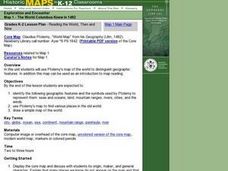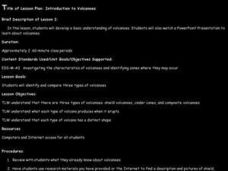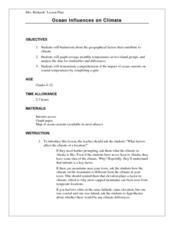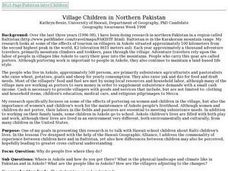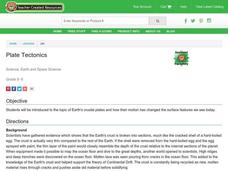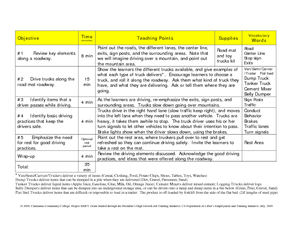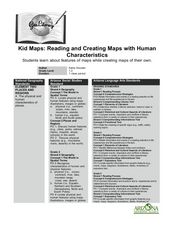Curated OER
Six Billion and Beyond
Students consider the idea of a world with Six Billion people and subsequent results and ramifications. Then students will gather data regarding the state of these diverse nations and then create a presentation as a culminating activity.
Curated OER
Finding Fibonacci
Students study and apply the Fibonacci numbers and how they occur in nature. Students solve problems using the Fibonacci numbers.
Curated OER
Bioweapons - Are You Safe?
Students investigate bioterrorism and bioweapons as ways to transmit contagious diseases. Student examine the way the US is protecting itself from bioterrorism.
Curated OER
Traveling to Texas
First graders read "Where the River Begins" by Thomas Locker and discuss the Texan landscape. They use construction paper to make suitcases and then fill them with types of Texan landforms and scenery they might see on a trip to Texas.
Curated OER
Reading the World, Then and Now
Students distinguish geographic features using Ptolemy's map of the world.
Curated OER
Introduction to Volcanoes
Students develop a basic understanding of volcanoes. They watch a PowerPoint Presentation which introduces three types of volcanoes: shield volcanoes, cinder cones, and composite volcanoes.
Curated OER
Landscape Book
Students create a three-dimensional book about landscapes. They must show their understanding of shape, color and balance.
Curated OER
Ocean Influences on Climate
Students brainstorm the geographical factors that contribute to climate. They graph average monthly temperatures at two island groups. They analyze data for similarities and differences.
Curated OER
Our Ever Changing Earth
First graders discover plate tectonics. They observe the forces of erosion. They observe the forces of weathering. They state three ways the earth changes. They record observations and make conclusions about their observations.
Curated OER
Utah's Biomes
Fourth graders discover what a biome is and study biomes that are native to Utah in this series of lessons. They examine how Utah's biomes have changed over time due to the influence of the Mormon pioneers and other human populations.
Curated OER
Village Children in Northern Pakistan
Student use maps to answer geographic questions. They analyze Earth's surface by using a map to identify physical features that lead to different transportation routes. Student create a collage to show geographic insight into the topic...
Curated OER
Plate Tectonics
Students watch a video about plate tectonics. in this Earth Science lesson, students watch a video clip from Bill Nye about Continental Drift and Plate Tectonics. They make a slight crack in a hard boiled egg and manipulate the egg to...
Curated OER
Earthquakes
Sixth graders explore reasons for earthquakes. They discuss and describe the types of faults. Using the internet, 6th graders research a specific location of a former earthquake. They describe the damage, magnitude, the epicenter,...
Curated OER
An Early American Culture
Pupils identify the locations of the Hopewell culture. In this map skills lesson, students use a globe to mark several locations of the Hopewell culture.
Curated OER
Plate Tectonics
Students complete a data sheet. In this Earth composition lesson, students learn what happens when the Earth's plates push against each other. They watch a teacher demonstration and complete a data sheet.
Curated OER
Trucks on the Roadway
Students explore trucks. In this truck and road safety lesson, students identify different types of trucks and define traffic and truck vocabulary. Students manipulate toy trucks on a road floor mat.
Curated OER
Lewis and Clark Expedition
Fourth graders read excerpts and research the Internet to learn about the expeditions of Lewis and Clark and their impact on the United States. Students fill out a KWL chart as they learn.
Curated OER
Sand Art Creation
Students create a model of a geological land-form. In this art lesson, students will create a model of a land-form using sand.
Curated OER
Map Keys
Third graders examine maps and map keys. In this locating map features lesson, 3rd graders use crayons, markers and colored pencils to label maps. Students work in partners to read map keys and locate given places and things.
Curated OER
Measure for Measure: Weight and Energy
Students study the friction of a particular sport. In this weight and energy lesson students choose a sport and us the Internet to research it then present their findings to the class.
Curated OER
Kid Maps: Reading and Creating Maps with Human Characteristics
Young scholars look at maps. In this map lesson, students listen to the book My Map Book by Sara Fanelli and they see the difference between human characteristics (buildings, etc.) and natural characteristics (rivers, etc.). They create...
Curated OER
Volcanoes!
Students define what a volcano is. They discover where and why volcanoes occur. They study effects of volcanoes on the Earth system.
Curated OER
The Battle of Glorieta Pass: A Shattered Dream
This lesson can be used in American history, social studies, and geography courses in units on westward expansion and the Civil War.
Curated OER
Food Web Mystery
Students describe typical marine food webs, and explain why food is generally scarce in the deep-ocean environment. They discuss reasons that seamounts may support a higher density of biological organisms than would appear to be possible.
Other popular searches
- Andes Mountains
- Appalachian Mountains
- Himalaya Mountains
- Math Mountains
- Rocky Mountains
- Fold Mountains
- Allegheny Mountains
- Great Smoky Mountains
- North Carolina Mountains
- Blue Ridge Mountains
- Miniature Mountains
- Types of Mountains






